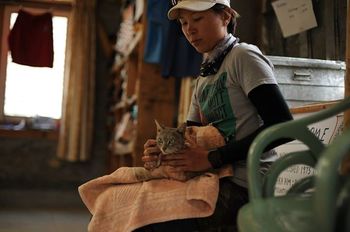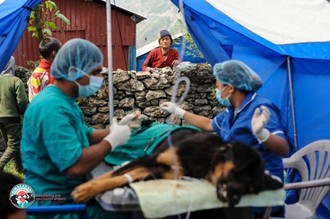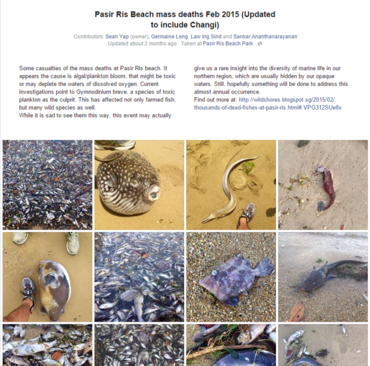Debby Ng is the founder of the Hantu Blog and the Himalayan Mutt Project. She talks to Shermaine Wong about her work for Mallika Naguran's talk on the "Face of the Conservationist", for theMEM Alumni Group and the Nature Society seminar.
Singapore, 12 May 2015
How did you first get involved in conservation advocacy?

Debby Ng, founder of the Hantu Blog and co-founder of the Himalayan Mutt Project. Photo credit: Debby Ng/Himalayan Mutt Project.
My first exposure to working with wildlife was with TRAFFIC (wildlife trade monitoring network; a joint programme of WWF and IUCN) in South East Asia. I started working as a researcher in illegal wildlife trade. But before that, I was passionate about animal welfare. Conservation advocacy for me was borne out of concern for animal welfare. I started volunteering at animal welfare organisations when I was ten years old. When interacting with people with different concerns about animal welfare, I learnt about conserving nature and wildlife.
What were some challenges that you faced in the past 10 or so years?
For the Hantu Blog, one of the biggest challenges was getting volunteers to participate. The first several years of the Hantu Blog was run entirely by me; if I stop doing anything, the Hantu Blog stops doing anything. But the wonderful thing now, perhaps because of greater awareness of marine life and of what we do, more divers have come forward to volunteer, and not volunteer on an ad-hoc basis. These are people who are committed in the long term.
The most experienced Hantu Blog volunteer has around eight to ten years of experience, and these are the kinds of volunteers that we want, passionate and committed, with real skills that can be shared and transferred to others. At first, the Hantu Blog was more of an outdoor sport activity. We wanted really to reach out to the larger community in Singapore, and we are still trying to develop the manpower of the team. Major challenges include the need for people to physically participate and to get the kind of committed, long-term and skilled volunteers that can help the Hantu Blog.
As for the Himalayan Mutt project, the main challenge is fund-raising. We have a very lean team but efficient. In terms of manpower, we don’t need a lot of people. We need volunteers that have very specific skills – vet or nurses, animal handlers. What we are looking for now is to get suitable accreditation that will give us some kind of financial stability. It is a public health and environmental project which was started because we want to protect wildlife and take care of the feral dog population. So we have to educate financial supporters on why is it important to give us financial support.
What nature and conservation work are you involved in at present and what are some plans for the next couple of years?
That’s an interesting question because none of these projects were planned; they were created to serve a need that was realised. What drove me for Hantu Blog was that back in 2003, Shell, which owns an oil refinery next to Pulau Hantu, was starting a land reclamation project. If no one knew about Pulau Hantu reefs, then potential damage could not be recognised. Lack of knowledge is very dangerous, to not know what was lost. So what inspired the Hantu Blog, was that people demonstrated through the diving forums – my main platform for sharing information – that they were interested. Hantu Blog was thus borne out a dire need due to time pressure, and public interest to generate momentum for such a project.

A villager looks on as vets and technicians carry our neutering procedure on a local mutt. Photo credit: Debby Ng/Himalayan Mutt Project.
The Himalayan Mutt Project was inspired because I was there and happened to learn about the attacks that the dogs made on red pandas and musk deer. Casual talking with villages made me realise that there was a need, so it was a similar situation as the Hantu Blog, people were interested in having something done. I would say one of the skills that I have is to network different people, to accomplish certain needs. So I don’t actually plan to start any specific projects but they come about in my process of experiencing the community around me. If the community is keen and motivated and if I have the capacity to address their needs, I will step in to do something.
What troubles you still with regard to the conservation of nature and biodiversity in Singapore?

Example of how everyday citizens can spread news about the environment, engaging their friends and families through social media.
One of the things that’s very encouraging in Singapore now, is that we are in a situation where we are all very technologically connected, Facebook, Instagram, Reddit, and following environmental blogs. There is a lot of access to information in Singapore, and we are very active on social media, so there is a large community that wouldn’t have on their own, be exposed to things about nature or the wonderful things we have in Singapore.
Advocacy is a three-part cycle, it starts with knowledge, and then caring about what you know. Finally, advocacy comes about when we start to do something about what we care about.
In Singapore, we have a lot of people who know about stuff, the environment, deforestation and so on. We have a lot of knowledge, and people are very educated. But whether we care or not, is something, as a society, that we really need to develop and social media has brought about a wonderful shift in perception. For example, people now know that otters can be found in places like Bishan-Ang Mo Kio Park, Sungei Buloh, Pasir Ris Park. Before, if you want to see wildlife, you went to the zoo. Now you have a group of people willing to go into the wild and be open to potential disappointment. It is a special privilege to see them in the wild. Having people connecting with the environment, caring about it and being motivated to do something about it is important. I think people have to find a balance in their lives to make time to do something about the things they care about.
Finally, what do you think are some probable solutions to addressing these problems?
Connecting people with the environment, making them care about it and be motivated to do something about it, is something that is a responsibility of organisations like the Hantu Blog and individuals that care about nature. What social media has given to us, is that when we share info, we have a chance of reaching out to somebody who would care but just didn’t know about it.
While the Hantu Blog is an education and awareness organisation, in their personal capacity, people who have a passion for wildlife, photographers, birdwatchers or hikers, people who already have an appreciation of nature, can also share with those around them about the environment in Singapore. I think these steps will lead to people connecting with nature, and then out of these people, there will be some who will be motivated to integrate into their lives the responsibility and stewardship of being responsible for our environment and the nature that is within it.
